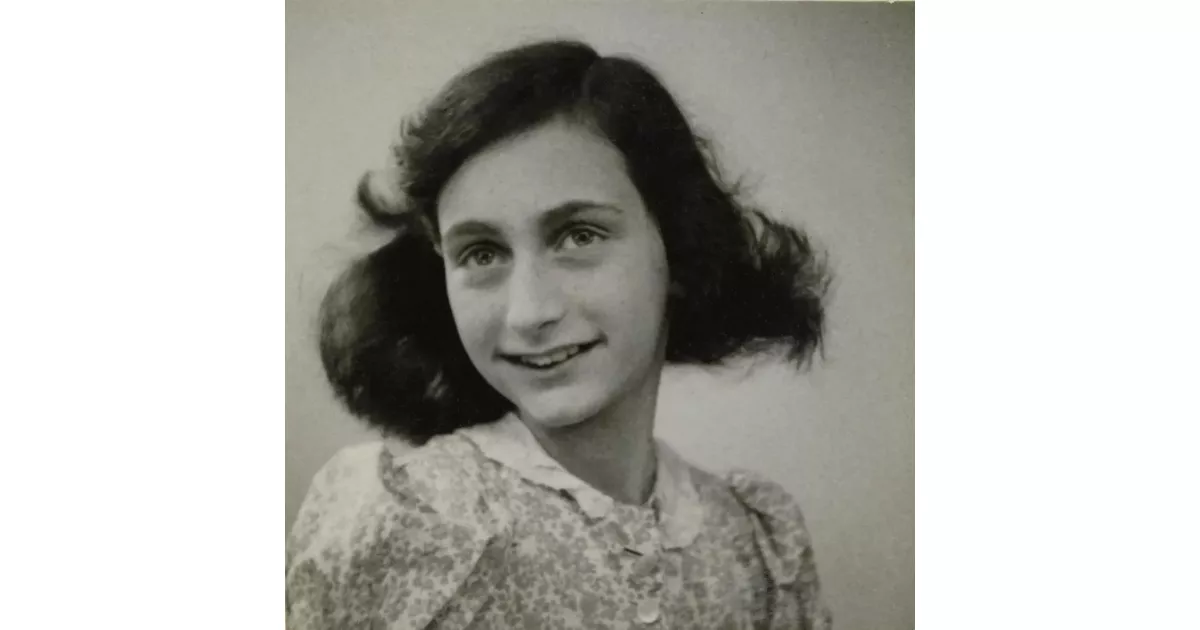Anne Frank was a German-Jewish girl who gained posthumous fame for her diary, which documented her family's life in hiding during the Nazi occupation of the Netherlands. Published in 1947 as "The Diary of a Young Girl," it recounts their experiences in an Amsterdam attic from 1942 to 1944. Anne's diary is celebrated for its poignant depiction of everyday life under persecution and has become a literary cornerstone for understanding the Holocaust's impact on individuals.
1923: Birth of Nelly Voskuijl
Nelly Voskuijl, who would later be implicated in the betrayal of Anne Frank, was born in 1923.
1931: The Frank Family Moves to Ganghoferstrasse
In 1931, the Frank family moved to Ganghoferstrasse 24 in a liberal area of Frankfurt.
1933: Frank Family Moves to Merwedeplein Apartment
The Frank family resided in the Merwedeplein apartment from 1933 to 1942.
April 1934: Anne Frank Enrolls in the 6th Montessori School
On April 9th, 1934, Anne Frank enrolled in the 6th Montessori School in Amsterdam.
1938: Otto Frank Starts Pectacon
Otto Frank started a second company called Pectacon in 1938.
1939: 300,000 Jews Flee Germany
Between 1933 and 1939, 300,000 Jews, including the Frank family, fled Germany due to Nazi persecution.
1939: Hermann van Pels Joins Pectacon
Hermann van Pels joined Otto Frank's company, Pectacon, in 1939.
May 1940: German Occupation of the Netherlands
In May 1940, Germany invaded the Netherlands, trapping the Frank family in Amsterdam.
May 1940: German Invasion Thwarts Emigration Plans
The Frank family's plans to emigrate to the United States were thwarted by the German invasion of the Netherlands in May 1940.
September 1941: Anne Frank Attends Jewish Lyceum
Anne Frank began attending the Jewish Lyceum in Amsterdam in September 1941 due to Nazi regulations prohibiting Jewish children from attending regular schools.
1941: Only Known Footage of Anne Frank
A silent film from 1941 captured the only known footage of Anne Frank, where she is seen leaning out of a window to see her neighbor's wedding.
1941: Anne Frank Meets Bloeme Evers-Emden
Anne Frank befriended Bloeme Evers-Emden in 1941 while attending the Jewish Lyceum in Amsterdam.
1941: Anne Frank Loses German Citizenship
Anne Frank lost her German citizenship in 1941 under Nazi persecution and became stateless.
1941: Anne Frank's Education at the 6th Montessori School
Until 1941, Anne Frank was a student at the 6th Montessori School in Amsterdam, one of many institutions later named in her memory.
January 1942: Death of Edith Frank's Mother
Edith Frank's mother, who had been living with the Franks, passed away in January 1942.
June 1942: Anne Frank Receives Her Diary
Anne Frank received a diary as a birthday present on June 12th, 1942, in which she documented her experiences during the Holocaust.
July 1942: Start of Deportation and Plans for Hiding
In July 1942, as the systematic deportation of Jews from the Netherlands began, the Frank family's plans to go into hiding were accelerated. When Margot received a call-up notice from the Zentralstelle für jüdische Auswanderung on July 5th, they decided to move their hiding date forward by ten days. Before going into hiding, Anne gave her friend, Toosje Kupers, a book, tea set, and marbles for safekeeping.
July 1942: The Frank Family Goes into Hiding
In July 1942, the Frank family went into hiding in a secret annex behind Otto Frank's workplace to escape Nazi persecution.
July 1942: New Arrivals and Growing Tensions
The Van Pels family, Hermann, Auguste, and 16-year-old Peter joined the Franks in hiding on July 1942. In November, Fritz Pfeffer, a dentist and family friend, also joined them. The close quarters led to some tensions, especially between Anne and Auguste van Pels and later with Fritz Pfeffer.
November 1942: Anne's Complex Relationship with Her Mother
In November 1942, Anne wrote about her strained relationship with her mother, Edith, expressing "contempt" for her. However, as Anne matured, she recognized her own role in their misunderstandings and began to treat her mother with more tolerance and respect.
1942: Anne Frank Begins Writing in Her Diary
Anne Frank began writing in her diary in 1942, documenting her experiences during the Holocaust.
1942: Deportation of Jews from the Netherlands
Between 1942 and 1944, over 100,000 Jews were deported from the Netherlands by the Nazis.
1942: Frank Family Leaves Merwedeplein Apartment
The Frank family left their apartment on Merwedeplein in 1942.
1942: Discovery of Asteroid Later Named After Anne Frank
The asteroid that would later be named after Anne Frank was discovered in 1942.
January 1944: Evolving Relationships in Hiding
By January 1944, Anne and Margot began to develop a closer relationship than they had before going into hiding. Anne notes this change in her diary, writing "Margot's much nicer… She's not nearly so catty these days and is becoming a real friend.
February 1944: Hanneli Goslar Arrives at Bergen-Belsen
Hanneli Goslar, a friend of Anne Frank, was imprisoned in the Sternlager section of Bergen-Belsen from February 1944.
March 1944: Anne Frank begins editing her diary for potential publication
In March 1944, inspired by a radio broadcast, Anne Frank started editing her diary with the intention of publishing it after the war.
March 1944: Education and Introspection in the Annex
The Frank sisters continued their education while in hiding. Margot took a correspondence course in Latin, while Anne devoted much of her time to reading, studying, and writing in her diary. As her writing progressed, she began to reflect on more profound subjects like her faith and human nature.
April 1944: Anne's Aspiration to be a Journalist
On April 5, 1944, Anne confided in her diary her dream of becoming a journalist after the war. She continued to write regularly, documenting her experiences and thoughts.
August 1944: Possible Sighting of Ans van Dijk at Sicherheitsdienst Building
According to a witness account mentioned in a 2018 book, Ans van Dijk was seen visiting the Sicherheitsdienst building and overheard discussing Prinsengracht, the location of the Frank family's hiding place, with Nazi officers in August 1944.
August 1944: Anne's Last Diary Entry
Anne Frank wrote her final diary entry on August 1, 1944.
August 1944: Aftermath of the Arrest
Following the arrest, Victor Kugler and Johannes Kleiman were imprisoned, while Miep Gies and Bep Voskuijl, narrowly escaped arrest. Despite the threats, the women returned to the Achterhuis and collected Anne's writings and photographs, preserving her legacy for future generations.
August 1944: The Discovery and Arrest
On August 4, 1944, the Frank family's hiding place was raided by the Grüne Polizei, led by SS-Oberscharführer Karl Silberbauer. The Franks, the Van Pels family, and Fritz Pfeffer were arrested and taken to RSHA headquarters for interrogation. They were held overnight and then transferred to an overcrowded prison.
August 1944: The Frank Family's Arrest
The Frank family was discovered and arrested by the Gestapo in August 1944, ending their two years in hiding.
September 1944: Deportation to Auschwitz
In September 1944, the Frank family was deported from Westerbork to Auschwitz concentration camp. They were on the last transport from Westerbork to Auschwitz.
October 1944: Separation from Bloeme Evers-Emden at Auschwitz
Anne Frank was separated from her friend Bloeme Evers-Emden in October 1944 at Auschwitz. Anne had contracted scabies and was deemed unfit for transport to the Liebau labor camp, while Bloeme was sent.
November 1944: Transfer to Bergen-Belsen
Anne and Margot Frank were transferred from Auschwitz to Bergen-Belsen concentration camp in November 1944.
December 1944: Anne Reunites with Nanette Blitz at Bergen-Belsen
Anne Frank was briefly reunited with her friend, Nanette Blitz, on December 5, 1944, after being transferred to the same section of Bergen-Belsen concentration camp.
1944: Anne Frank's Final Diary Entry
Anne Frank's final diary entry was written in 1944, before her capture by the Nazis.
1944: Deportation of Jews from the Netherlands
Between 1942 and 1944, over 100,000 Jews were deported from the Netherlands by the Nazis.
February 1945: Last Encounters with Friends at Bergen-Belsen
Anne Frank had her last encounters with her friends Hanneli Goslar and Nanette Blitz in late January or early February 1945 at Bergen-Belsen. Both Blitz and Goslar survived the war and later shared their memories of Anne's frail condition and her fading hope.
February 1945: Revised estimated time of death for Anne and Margot Frank
Research in 2015 suggested that Anne and Margot Frank may have died earlier than previously thought, possibly in February 1945, due to typhus.
March 1945: Death of Anne Frank
Anne Frank died in February or March 1945 at Bergen-Belsen concentration camp, likely due to a typhus epidemic that ravaged the camp.
April 1945: Liberation of the camp and initial belief about the Frank sisters' deaths
In April 1945, British troops liberated the camp where Anne Frank and her sister Margot were imprisoned. It was initially believed that they died just a few weeks before the liberation.
June 1945: Otto Frank's return to Amsterdam and discovery of his daughters' fate
In June 1945, after surviving Auschwitz, Otto Frank returned to Amsterdam and learned about the deaths of his wife and daughters, Anne and Margot.
July 1945: Otto Frank receives Anne's diary and discovers her writing
Otto Frank received Anne's diary in July 1945 and discovered the extent of her writing talent and her inner thoughts.
1945: Otto Frank Informs His Mother of His Family's Fate
In 1945, Otto Frank sent a letter to his mother informing her about the loss of his wife and daughters in Nazi concentration camps.
April 1946: An article about Anne Frank's diary sparks public interest
An article titled "Kinderstem" ("A Child's Voice") about Anne Frank's diary was published in April 1946, garnering public interest and paving the way for its publication.
1947: First publication of Anne Frank's diary in the Netherlands
Anne Frank's diary was published for the first time in 1947 in the Netherlands under the title "Het Achterhuis" ("The Annex").
1947: Publication of Anne Frank's Diary
Anne Frank's diary, documenting her family's time in hiding during the Holocaust, was published in 1947.
1947: Otto Frank Publishes Anne's Diary
Otto Frank, the sole survivor of the Frank family, returned to Amsterdam and published Anne's diary in 1947.
1950: Anne Frank's diary published in Germany and France
Anne Frank's diary was published in Germany and France in 1950, marking its expansion beyond the Netherlands.
1950: Death of Arnold van den Bergh
Arnold van den Bergh, the suspected informant identified in the 2022 investigation, died in 1950.
1950: Five printings of Anne Frank's diary
By 1950, Anne Frank's diary had been printed five times in the Netherlands.
1952: English Translation of Anne Frank's Diary Published
Anne Frank's diary was translated and published in English as "The Diary of a Young Girl" in 1952, further amplifying her story to a global audience.
1952: Anne Frank's diary published in the United Kingdom and the United States
The year 1952 marked the publication of Anne Frank's diary in the United Kingdom and the United States, introducing her story to a wider audience.
1953: Anne Frank's diary goes out of print in the United Kingdom
Despite its success in other countries, Anne Frank's diary failed to attract a large readership in the United Kingdom and went out of print in 1953.
October 1955: Premiere of the play based on Anne Frank's diary
A play based on Anne Frank's diary premiered in New York City in October 1955 and went on to win a Pulitzer Prize for Drama.
May 1957: Establishment of the Anne Frank Stichting
In May 1957, a group of Dutch citizens, including Otto Frank, established the Anne Frank Stichting to save the Prinsengracht building from demolition.
1957: Anne Frank's School Renamed
In 1957, the 6th Montessori School, where Anne Frank studied, was renamed "Anne Frank School" in her honor.
1957: First Published Criticisms of Anne Frank's Diary Emerge
The earliest published criticisms of the authenticity of Anne Frank's diary surfaced in 1957, with a Swedish neofascist magazine alleging it was fabricated.
1958: Simon Wiesenthal Challenged to Prove Anne Frank's Existence
During a performance of "The Diary of Anne Frank" in Vienna in 1958, Simon Wiesenthal was confronted by Holocaust deniers, prompting his search for the man who arrested her.
1959: Premiere of "The Anne Frank Ballet"
Adam Darius's ballet "The Anne Frank Ballet" premiered in 1959, marking an early artistic interpretation of her life.
1959: Otto Frank Takes Legal Action Against Holocaust Deniers
In 1959, Otto Frank initiated legal action against individuals who publicly denounced Anne Frank's diary as a forgery, leading to a court examination and authentication of the diary's handwriting.
1959: Release of the film "The Diary of Anne Frank"
The film adaptation of Anne Frank's diary, titled "The Diary of Anne Frank", was released in 1959 and achieved both critical and commercial success.
May 1960: Opening of the Anne Frank House
The Anne Frank House, consisting of the Opekta warehouse, offices, and the Achterhuis, opened to the public in May 1960. It preserves the spaces as they were, with some personal relics on display.
1960: Court Authenticates Anne Frank's Diary
After examining the handwriting in 1960, the court declared Anne Frank's diary genuine, refuting the claims made by Holocaust deniers.
1961: Prominent figures recognize the impact of Anne Frank's diary
In 1961, public figures like Eleanor Roosevelt and John F. Kennedy acknowledged the profound impact of Anne Frank's diary on readers worldwide.
1963: Creation of the Anne Frank Fonds
Otto Frank and his second wife established the Anne Frank Fonds in 1963 as a charitable foundation based in Basel, Switzerland, to manage the rights to Anne Frank's diary and promote her legacy.
1963: Karl Silberbauer Confirms Anne Frank's Arrest
Simon Wiesenthal located Karl Silberbauer, the man who arrested Anne Frank, in 1963. Silberbauer's testimony corroborated the accounts of Anne Frank's arrest, supporting the authenticity of her diary.
1970: Daycare Center Named After Anne Frank
In 1970, a daycare center in Tangerhütte, Germany, was named after Anne Frank, a testament to her lasting impact.
1976: Otto Frank Pursues Legal Action Against Further Holocaust Denial
Otto Frank continued to take legal action against individuals spreading misinformation about Anne Frank's diary, including Heinz Roth in 1976, further solidifying the diary's legitimacy.
1976: Legal Proceedings Against Ernst Römer and Edgar Geiss
Otto Frank filed a lawsuit against Ernst Römer for distributing pamphlets denying the authenticity of Anne Frank's diary. Edgar Geiss also faced legal action for distributing the same pamphlet in court.
1978: Heinz Roth's Appeal Against Court Ruling on Anne Frank's Diary Dismissed
Following Heinz Roth's death in 1978, his appeal against the court ruling that upheld the authenticity of Anne Frank's diary was rejected.
1980: Otto Frank Wills Anne Frank's Diary to the Dutch Institute for War Documentation
After Otto Frank's death in 1980, Anne Frank's original diary and other writings were bequeathed to the Dutch Institute for War Documentation, ensuring their preservation and accessibility.
1986: Forensic Study Confirms Authenticity of Anne Frank's Diary
A forensic study commissioned by the Dutch Institute for War Documentation in 1986 provided further confirmation of the authenticity of Anne Frank's diary through analysis of handwriting, paper, glue, and ink.
1988: Bloeme Evers-Emden Interviewed for "The Last Seven Months of Anne Frank"
Bloeme Evers-Emden, who was imprisoned in Auschwitz with Anne Frank, shared her memories of the Frank family in a 1988 television documentary titled "The Last Seven Months of Anne Frank."
1990: Hamburg Regional Court Affirms Anne Frank's Diary as Authentic
The authenticity of Anne Frank's diary was once again affirmed in 1990 by the Hamburg Regional Court, solidifying its status as a historical document.
1991: Holocaust Deniers Continue Attempts to Discredit Anne Frank's Diary
Holocaust deniers Robert Faurisson and Siegfried Verbeke published a booklet in 1991, reviving debunked claims about Anne Frank's diary and reigniting the debate about its authenticity.
1993: Anne Frank House and Anne Frank Fonds File Lawsuit to Prevent Further Dissemination of Holocaust Denial Material
In 1993, the Anne Frank House and the Anne Frank Fonds took legal action to stop the spread of publications denying the authenticity of Anne Frank's diary, aiming to counter Holocaust denial.
1994: Anne Frank's Legacy Recognized
In 1994, Anne Frank's legacy was highlighted by prominent figures such as Hillary Clinton and Nelson Mandela, who recognized her as a symbol of the Holocaust and drew parallels to contemporary events and struggles against oppression.
1995: Asteroid Named After Anne Frank
Asteroid 5535 Annefrank, discovered in 1942, was named in her honor in 1995.
1995: Bloeme Evers-Emden Featured in "Anne Frank Remembered"
Bloeme Evers-Emden's recollections of Anne Frank were featured in the 1995 BBC documentary "Anne Frank Remembered."
1997: Opening of the Anne Frank Educational Centre
The Anne Frank Educational Centre opened in Frankfurt in 1997, where the Frank family lived until 1934, as a place for learning about the history of National Socialism and its relevance today.
1998: Amsterdam Court Rules in Favor of Anne Frank House, Prohibits Denial of Diary's Authenticity
The Amsterdam District Court ruled in favor of the Anne Frank House in 1998, prohibiting the denial of Anne Frank's diary's authenticity and imposing penalties for violations.
June 1999: Anne Frank Named One of Time's Most Important People of the Century
In June 1999, Time magazine recognized Anne Frank as one of the "Heroes & Icons" of the 20th century, acknowledging her impact on the world and praising her writing talent.
1999: Anne Frank Named One of the Most Important People of the 20th Century
Time magazine recognized Anne Frank as one of the most important people of the 20th century in 1999 for her courage and powerful voice for human dignity.
2001: Death of Nelly Voskuijl
Nelly Voskuijl, the suspected informant in the Anne Frank case, died in 2001.
2001: Previously Edited Sections of Anne Frank's Diaries Published
New editions of Anne Frank's diaries, released after an ownership dispute in 2001, included previously omitted passages, offering a more complete and uncensored view of her thoughts and experiences.
2003: Loan of Anne Frank's Papers and Global Efforts
The Anne Frank Fonds loaned some of Anne Frank's papers to the United States Holocaust Memorial Museum in 2003 and outlined its global efforts in its annual report.
2005: Restoration and Opening of the Merwedeplein Apartment
After being featured in a documentary, the dilapidated Merwedeplein apartment was restored to its 1930s appearance and opened to the public in 2005, offering a writer's residency program.
2005: Debut of Choral Work "Annelies"
The choral work "Annelies," inspired by Anne Frank's life, premiered in 2005.
2006: Anne Frank Included in the Canon of the Netherlands
Anne Frank was included in the Canon of the Netherlands, a list of fifty important topics in Dutch history, in 2006.
June 2007: Donation of Frank Family Documents
"Buddy" Elias donated 25,000 family documents, including photos and letters, to the Anne Frank House in June 2007.
October 2007: Revised Canon of the Netherlands Presented
A revised version of the Canon of the Netherlands, which included Anne Frank as a topic, was presented to the Dutch government in October 2007.
November 2007: Anne Frank Tree Scheduled for Felling
The Anne Frank tree, suffering from a fungal disease, was scheduled to be cut down in November 2007 to protect surrounding buildings, sparking international attention.
August 2010: Anne Frank Tree Falls
Despite efforts to save it, the Anne Frank tree was blown down by strong winds in August 2010.
2012: Unveiling of Anne Frank Wax Figure
Madame Tussauds wax museum unveiled an exhibit featuring a likeness of Anne Frank in 2012.
April 2013: First Sapling from Anne Frank Tree Planted
The first sapling from the Anne Frank tree was planted at The Children's Museum of Indianapolis in April 2013 as part of a project to distribute them to various locations.
2015: Gena Turgel Shares Recollections of Anne Frank at Bergen-Belsen
Holocaust survivor Gena Turgel, who was in Bergen-Belsen with Anne Frank, recounted her memories of Frank's final days in a 2015 interview, describing her as delirious and suffering from the effects of typhus.
2015: Publication of Biography Alleging Betrayal
In 2015, a biography by Jeroen De Bruyn and Joop van Wijk suggested that Nelly Voskuijl, sister of Anne Frank's helper Bep Voskuijl, might have been the informant who betrayed the Frank family. Nelly, a known Nazi collaborator, had a history of conflict with her family over their support for the Franks.
2015: Premiere of "The Beauty That Still Remains"
Marcus Paus's choral work "The Beauty That Still Remains," also inspired by Anne Frank, premiered in 2015.
2015: New research challenges previous understanding of Anne Frank's death
New research emerged in 2015, suggesting that Anne Frank and her sister Margot might have died earlier than previously thought, challenging the long-held belief about the timeline of their deaths.
2016: New Research Suggests Ration Card Fraud as Possible Explanation for Raid
In 2016, the Anne Frank House published a report proposing that a raid related to ration card fraud, rather than betrayal, might have led to the arrest of the Frank family. However, the report didn't rule out the possibility of an informant.
2018: Book Suggests Ans van Dijk as Possible Informant
A 2018 book put forward Ans van Dijk, a Dutch Jew who collaborated with the Nazis, as a potential suspect in the betrayal of Anne Frank. The book cites witness accounts of Van Dijk discussing the area where the Franks were hiding with Nazi officials.
2018: Schools Named After Anne Frank Worldwide
As of 2018, over 270 schools globally were named in honor of Anne Frank, reflecting her enduring legacy.
2018: Hidden Passages in Anne Frank's Diary Deciphered
Two pages that Anne Frank had pasted over in her diary were deciphered in 2018, revealing previously unknown content, including her thoughts on sex education.
2020: Canon of the Netherlands Approved
The revised Canon of the Netherlands, which still included Anne Frank, was approved in 2020.
2020: First Anne Frank Children's Human Rights Memorial
The year 2020 saw the inauguration of the first Anne Frank Children's Human Rights Memorial, located near a high school in Maaleh Adumim, outside Jerusalem.
2021: Second Anne Frank Children's Human Rights Memorial Unveiled
In 2021, the second Anne Frank Children's Human Rights Memorial was unveiled in Antigua, Guatemala, further solidifying her legacy.
January 2022: Investigation Points to Arnold van den Bergh as Suspect
In January 2022, a team of investigators led by Rosemary Sullivan released a book, "The Betrayal of Anne Frank: A Cold Case Investigation," which named Arnold van den Bergh, a member of the Amsterdam Jewish Council, as the likely informant. The book's findings, however, were met with skepticism from several Holocaust scholars.
January 2022: Anne Frank Children's Human Rights Memorial Unveiling
In January 2022, the third in a series of Anne Frank Children's Human Rights Memorials was unveiled in Addis Ababa, Ethiopia, coinciding with International Holocaust Remembrance Day on January 27th.
March 2022: Dutch Publisher Apologizes for "The Betrayal of Anne Frank"
Following criticism from historians, Dutch publishing house Ambo Anthos issued an apology for publishing the Dutch translation of "The Betrayal of Anne Frank," acknowledging that they should have approached the book with more scrutiny. The publisher also halted further reprints pending a response from the book's researchers.
June 2022: Google Doodle Honors Anne Frank
On June 25th, 2022, a slideshow Google Doodle commemorated the 75th anniversary of the publication of Anne Frank's diary.
August 2022: Researcher Accuses "The Betrayal of Anne Frank" of Source Fraud
Dutch researcher Natasha Gerson published a report in August 2022 accusing "The Betrayal of Anne Frank" of manipulating source material. Gerson's report argued that the book distorted evidence to support its claims about Arnold van den Bergh.
2023: Controversy Over Daycare Center Renaming
A 2023 proposal to rename a Tangerhütte, Germany, daycare center, named after Anne Frank since 1970, sparked international opposition and was ultimately abandoned.
Mentioned in this timeline

John F Kennedy JFK was the th U S President...

Hillary Diane Rodham Clinton is an American politician lawyer and...

Google LLC is a multinational technology company specializing in online...
Germany officially the Federal Republic of Germany is a Western...

Cornell Iral Haynes Jr known as Nelly is an American...
France officially the French Republic is primarily located in Western...
Trending

1 month ago Bronny James' Second Lakers Start: Stats, Points, and Reaction Amidst Injuries.

2 months ago DeRozan Believes Clifford Can Be A Star; Kings Surprise Lineup Move.

1 month ago Deandre Ayton's Impact: Lakers' Undefeated Streak and His Drive After OKC Loss.

1 month ago Lane Kiffin Coaching Carousel: Florida's Expectations and Other Potential Targets Examined.

5 months ago Robin Williams' impact: Comic Strip memories, promposal help, and wacky awareness day.

8 months ago Tobias Harris Leads Pistons to Playoff Victory, Displaying Postseason Excellence Against Knicks
Popular

Stranger Things created by the Duffer Brothers is a popular...

XXXTentacion born Jahseh Dwayne Ricardo Onfroy was a controversial yet...
Turning Point USA TPUSA is an American nonprofit organization founded...

Bernie Sanders is a prominent American politician currently serving as...
The Kennedy Center Honors are annual awards recognizing individuals and...

Candace Owens is an American conservative political commentator and author...
